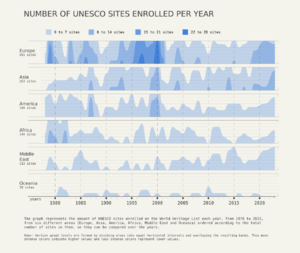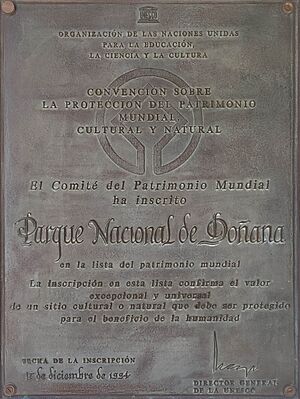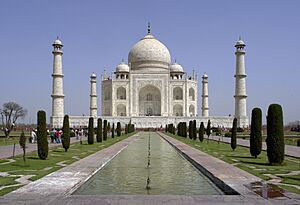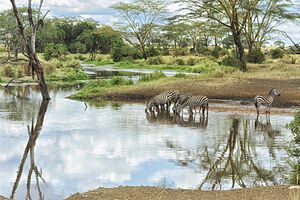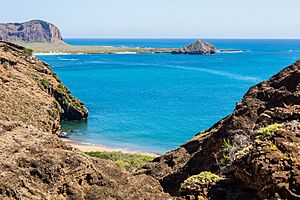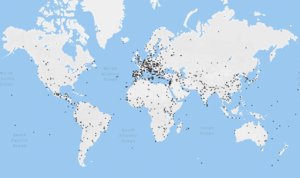World Heritage Site facts for kids
Quick facts for kids 
The World Heritage emblem, used to identify properties protected by the World Heritage Convention
|
|
| Formation | 1978 |
|---|---|
| Founded at | Galápagos Islands |
| Type | UNESCO Landmarks and areas legal protection and sites listing agency |
| Purpose | UNESCO landmarks and areas protection |
|
Region served
|
Worldwide |
|
Main organ
|
UNESCO |
World Heritage Sites are special places around the world. They can be landmarks, buildings, or natural areas. They are protected by an international agreement managed by UNESCO. These sites are chosen because they are very important for culture, history, or science. They are considered to be of great value to all people on Earth.
To become a World Heritage Site, a country suggests a place. Then, a group called the World Heritage Committee decides if it's unique and important enough. These sites can be old ruins, historic buildings, cities, deserts, forests, islands, mountains, or wild areas.
A World Heritage Site might show amazing things humans have built or learned. Or it could be a place of incredible natural beauty. As of July 2025, there are 1,248 World Heritage Sites in 170 countries.
These sites are protected so they can last for a very long time. This helps keep them safe from damage, too many visitors, or not being cared for. UNESCO marks these places as protected areas. The list of World Heritage Sites is managed by the World Heritage Program. This program helps find, name, and protect important cultural or natural places for everyone. The program started with an agreement in 1972. Since then, 196 countries have joined this agreement.
Contents
Protecting Our World's Treasures
How World Heritage Sites Began


The idea for World Heritage Sites started in the 1950s. The country of Egypt planned to build a large dam called the Aswan High Dam. This dam would create a huge lake. This lake would flood many ancient Egyptian and Nubian treasures in the Nile valley.
In 1959, Egypt and Sudan asked UNESCO for help. UNESCO is the United Nations Educational, Scientific and Cultural Organization. They wanted to save these important historical places.
In 1960, UNESCO started a big effort called the "International Campaign to Save the Monuments of Nubia." This project helped dig up and record hundreds of sites. Thousands of objects were saved. Several important temples, like Abu Simbel and Philae, were moved to higher ground.
This campaign finished in 1980 and was a big success. Many countries helped pay for it. As a thank you, Egypt gave four temples to countries that helped. For example, the Temple of Dendur went to a museum in New York City.
This successful project showed that countries could work together to save important places. It led to other efforts to protect sites like Venice in Italy and the Borobodur Temple in Indonesia. Because of this, UNESCO and other groups started to create an agreement to protect cultural heritage.
The World Heritage Agreement
The main agreement that guides World Heritage Sites is called the Convention Concerning the Protection of the World Cultural and Natural Heritage. It took seven years to create, from 1965 to 1972.
The United States first suggested the idea of protecting very important cultural or natural places. In 1965, they proposed a "World Heritage Trust." This trust would save amazing natural areas and historic sites for everyone in the world, now and in the future.
Other groups also made similar suggestions. Finally, in 1972, all countries agreed on one document. This agreement was adopted by UNESCO on November 16, 1972. It became active on December 17, 1975. As of November 2024, 196 countries have signed this agreement. This makes it one of the most popular international agreements for culture.
Why We Protect World Heritage Sites
UNESCO wants to keep World Heritage Sites safe for future generations. They believe that our heritage is a gift from the past. It is something we live with today. Both cultural and natural heritage are very important for our lives and ideas.
UNESCO has several goals for World Heritage. They want to encourage countries and local people to help protect these sites. They also offer help for sites in danger. They provide training and support activities to teach people about these important places.
When a place becomes a World Heritage Site, it gets worldwide attention and legal protection. It can also get money from the World Heritage Fund to help with its care. UNESCO has helped restore many sites. Some examples are Angkor in Cambodia and the Old City of Dubrovnik in Croatia.
Local people living near a site can also benefit. More tourists might visit, which can help the local economy. Sometimes, places where people and nature have worked together for a long time are called "cultural landscapes."
How a Place Becomes a World Heritage Site
First, a country makes a list of its important cultural and natural places. This is called a "Tentative List." From this list, the country chooses a site to nominate.
The nomination is then reviewed by two expert groups. These groups are the International Council on Monuments and Sites and the World Conservation Union. They check if the site is truly special.
These experts then give their advice to the World Heritage Committee. The Committee meets once a year. They decide which nominated places will be added to the World Heritage List. Sometimes, they ask for more information before making a decision. A site must meet at least one of ten special rules to be chosen.
What Makes a Site Special?
To be a World Heritage Site, a place must have "outstanding universal value." This means it is important for everyone in the world. It must also meet at least one of ten special rules or "criteria." Before 2005, there were separate rules for cultural and natural sites. Now, there is one list of ten rules.
Cultural Importance
A site might be chosen for its cultural importance if it:
- Shows amazing human creativity.
- Shows an important exchange of human ideas over time. This could be seen in architecture, technology, or city planning.
- Is a unique example of a culture or civilization that still exists or has disappeared.
- Is an excellent example of a building or landscape that shows a key time in human history.
- Is a great example of how people lived or used land or sea. This is especially true if it's now at risk.
- Is directly linked to important events, ideas, beliefs, or famous artworks and writings.
Natural Importance
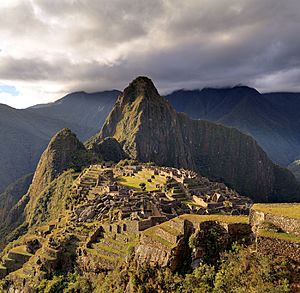
A site might be chosen for its natural importance if it:
- Has amazing natural features or areas of great beauty.
- Shows major stages of Earth's history. This includes how landforms developed.
- Is an excellent example of ongoing natural processes. This includes how plants and animals grow and change in their environments.
- Contains the most important natural homes for many different kinds of plants and animals. This includes places with endangered species.
Changes to World Heritage Sites
Sometimes, a country might want to change a site that is already on the list. They might ask to make the protected area bigger or smaller. They could also ask to change the site's official name.
If a country wants to make a big change, like greatly expanding the area, they have to go through almost the same process as nominating a new site. Smaller changes are also reviewed by experts before the Committee decides. Changes to a site's name go directly to the Committee.
Sites in Danger
Sometimes, a World Heritage Site faces serious threats. If conditions put the site's special features at risk, it can be added to the List of World Heritage in Danger. These problems can include natural disasters, pollution, illegal hunting, or too much building by humans.
This "danger list" helps tell the world about the threats. It encourages people to take action to protect the site. Experts check the condition of sites on the danger list every year. The Committee might ask for more help. If the threats are gone, the site can be removed from the danger list. But if a site is too damaged or no longer protected, it can be removed from the World Heritage List entirely.
Only three sites have ever been removed from the main list. The Arabian Oryx Sanctuary in Oman was removed in 2007. This happened after the government greatly reduced the protected area. The Dresden Elbe Valley in Germany was removed in 2009. This was because a new bridge changed the valley's landscape too much. Liverpool's World Heritage status in the United Kingdom was removed in July 2021. This was due to new buildings that changed the historic port area.
Studies show that many natural World Heritage Sites are facing threats. These include new roads, farms, and towns built nearby. These activities can harm the unique value of these places. For example, 91% of natural forest sites have lost some forest since 2000. Many sites need urgent help to be saved.
Protecting cultural sites is also very important. Some groups try to destroy historical places and cultural items. Organizations like the UN and UNESCO work with groups like Blue Shield International to prevent this. They create plans to protect cultural treasures from harm. It is important to have local people involved in protecting these sites.
World Heritage Sites by Region
The World Heritage Committee divides the world into five main areas. These are Africa, Arab states, Asia and the Pacific, Europe and North America, and Latin America and the Caribbean. For example, Russia is grouped with Europe. Mexico and the Caribbean are part of Latin America. These groups are sometimes based on how countries work together, not just where they are on a map. For instance, Gough Island is in the South Atlantic, but it's part of the Europe and North America region because the United Kingdom nominated it.
As of July 2025, here's how the 1,248 sites are spread out:
| Region | Cultural | Natural | Mixed | Total | Percentage | Countries with sites |
|---|---|---|---|---|---|---|
| Africa | 63 | 44 | 5 | 112 | 8.97% | 38 |
| Arab states | 88 | 6 | 3 | 97 | 7.77% | 18 |
| Asia and the Pacific | 220 | 73 | 13 | 306 | 24.52% | 36 |
| Europe and North America | 496 | 72 | 12 | 580 | 46.47% | 50 |
| Latin America and the Caribbean | 105 | 40 | 8 | 153 | 12.26% | 28 |
| Total | 972 | 235 | 41 | 1,248 | 100% | 170 |
Countries with Many Sites
Here are the 23 countries that have 15 or more World Heritage Sites, as of July 2025:
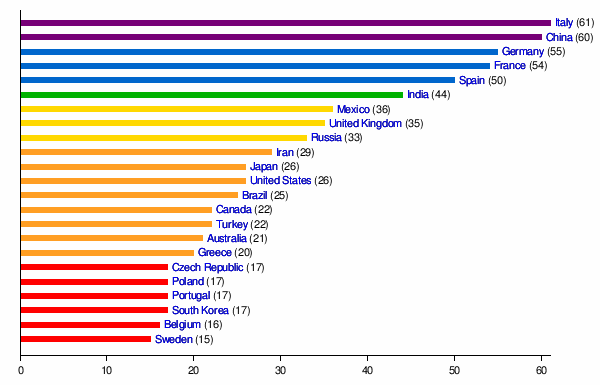
See also
 In Spanish: Patrimonio de la Humanidad para niños
In Spanish: Patrimonio de la Humanidad para niños
- GoUNESCO – an effort to help people learn about and get involved with heritage
- Index of conservation articles
- Lists of World Heritage Sites
- Former UNESCO World Heritage Sites
- Memory of the World Programme
- UNESCO Intangible Cultural Heritage Lists
- Ramsar Convention – an international agreement about protecting wetlands


